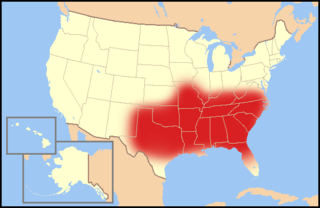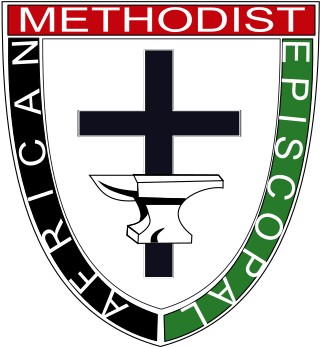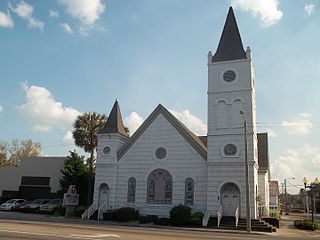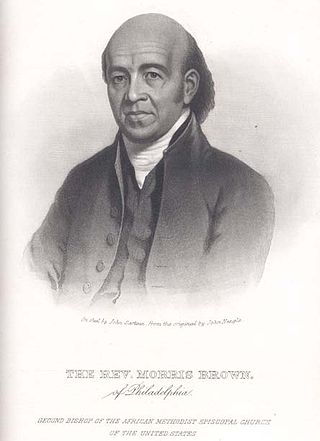
The Bible Belt is a region of the Southern United States and one Midwestern state, the state of Missouri, in all of which socially conservative Protestant Christianity plays a strong role in society. Church attendance across the denominations is generally higher than the nation's average. The region contrasts with the religiously diverse Midwest and Great Lakes, and the Mormon corridor in Utah,southern Idaho and northern Arizona.
The Methodist Episcopal Church, South was the American Methodist denomination resulting from the 19th-century split over the issue of slavery in the Methodist Episcopal Church (MEC). Disagreement on this issue had been increasing in strength for decades between churches of the Northern and Southern United States; in 1845 it resulted in a schism at the General Conference of the MEC held in Louisville, Kentucky.

The African Methodist Episcopal Church, usually called the AME Church or AME, is a Methodist Black church. It adheres to Wesleyan-Arminian theology and has a connexional polity. The first independent Protestant denomination to be founded by Black people, AME welcomes and has members of all ethnicities.

The African Methodist Episcopal Zion Church, or the AME Zion Church (AMEZ) is a historically African-American Christian denomination based in the United States. It was officially formed in 1821 in New York City, but operated for a number of years before then. The African Methodist Episcopal Zion Church adheres to Wesleyan-Arminian theology.

The black church is the faith and body of Christian denominations and congregations in the United States that predominantly minister to, and are also led by African Americans, as well as these churches' collective traditions and members. The term "black church" may also refer to individual congregations, including in traditionally white-led denominations.
Wallace Augustus Rayfield (1874–1941), was an American architect and educator. He was the second formally educated practicing African American architect in the United States.

Religion of black Americans refers to the religious and spiritual practices of African Americans. Historians generally agree that the religious life of black Americans "forms the foundation of their community life". Before 1775 there was scattered evidence of organized religion among black people in the Thirteen Colonies. The Methodist and Baptist churches became much more active in the 1780s. Their growth was quite rapid for the next 150 years, until their membership included the majority of black Americans.
The civil rights movement (1865–1896) aimed to eliminate racial discrimination against African Americans, improve their educational and employment opportunities, and establish their electoral power, just after the abolition of slavery in the United States. The period from 1865 to 1895 saw a tremendous change in the fortunes of the Black community following the elimination of slavery in the South.
In January and February 2010, 10 churches were burned in East Texas.
Church arson is the burning of, or attempting to burn, religious property. Around the world, arson is committed because empty churches are a soft target, or due to excommunication, racial hatred, pyromania, prejudice against certain religions or religious beliefs, greed, as part of a sectarian campaign of communal violence, or as a means of anonymously registering dissent or anti-religious sentiment.

The Charleston church shooting, also known as the Charleston church massacre, was an anti-black mass shooting and hate crime that occurred on June 17, 2015, in Charleston, South Carolina. Nine people were killed, and one was injured, during a Bible study at the Emanuel African Methodist Episcopal Church, the oldest black church in the southern United States. Among the fatalities was the senior pastor, state senator Clementa C. Pinckney. All ten victims were African Americans. At the time, it was the deadliest mass shooting at a place of worship in U.S. history and is the deadliest mass shooting in South Carolina history.

Emanuel African Methodist Episcopal Church, colloquially Mother Emanuel, is a church in Charleston, South Carolina, founded in 1817. It is the oldest AME church in the Southern United States; founded the previous year in Philadelphia, Pennsylvania, AME was the first independent black denomination in the nation. Mother Emanuel has one of the oldest black congregations south of Baltimore.

Morris Brown was one of the founders of the African Methodist Episcopal Church, and its second presiding bishop. He founded Emanuel AME Church in his native Charleston, South Carolina. It was implicated in the slave uprising planned by Denmark Vesey, also of this church, and after that was suppressed, Brown was imprisoned for nearly a year. He was never convicted of a crime.
Mount Zion AME Church was an African Methodist Episcopal Church in Greeleyville, South Carolina. The church building burned on June 20, 1995, as the result of arson by two Ku Klux Klan members. In 1996, President Bill Clinton traveled to Greeleyville for the dedication of the rebuilt church. The church was destroyed by fire again in June 2015 after being struck by lightning during an electrical storm.
The Macedonia Baptist Church is a centuries-old historically black church located in rural Clarendon County, South Carolina. It was destroyed by arsonists following direction from the local Ku Klux Klan chapter known as the Christian Knights of the Ku Klux Klan and was later rebuilt afterwards. Four Klansmen were convicted for the crime, and a subsequent civil suit effectively closed the Klan chapter's operation in the county. The successful civil suit was called a "wake-up call" indicating that racial violence would not be tolerated.

Three Louisiana black churches were set alight by a suspected arsonist between March 26 and April 4, 2019. The first fire occurred at St. Mary Baptist Church in Port Barre on March 26. Ten days later, two other historic black churches, Greater Union Baptist Church and Mount Pleasant Baptist Church in Opelousas, Louisiana, were also set on fire—on April 2 and April 4 respectively. The suspect used gasoline at each church, destroying them completely.

The Black Belt in the American South refers to the social history, especially concerning slavery and black workers, of the geological region known as the Black Belt. The geology emphasizes the highly fertile black soil. Historically, the black belt economy was based on cotton plantations – along with some tobacco plantation areas along the Virginia-North Carolina border. The valuable land was largely controlled by rich whites, and worked by very poor, primarily black slaves who in many counties constituted a majority of the population. Generally the term is applied to a larger region than that defined by its geology.









